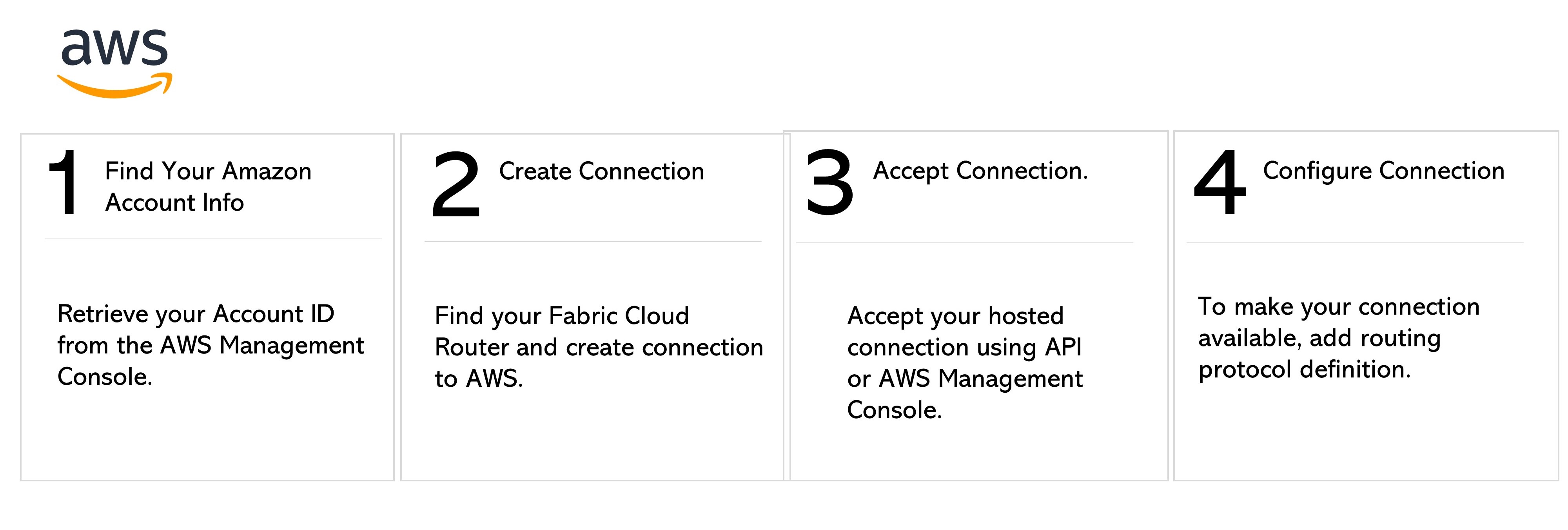Connect Fabric Cloud Router To Amazon Web Services
Establish a direct layer 2 connection between your Fabric Cloud Router and your Amazon Web Services (AWS)resource.

Identify Your Amazon Account ID
Log in to AWS Management Console and locate your account number.
Refer to the AWS Documentation for instructions on how to find your account number.
Identify Your Fabric Cloud Router
If you already have a Fabric Cloud Router, find it by sending a GET request to the fabric/v4/routers/{routerId} endpoint or search for one using the /fabric/v4/routers/search endpoint.
If you do not have a Fabric Cloud Router, you can create one.
Authenticate
Submit your user credentials, Client ID, and Client Secret for OAuth2 authentication. Refer to API Authentication for instructions on how to create your client ID, client secret, and how to call Oauth API to validate and authenticate your credentials.
If you are unaware of your user credentials for Equinix APIs, contact your local Equinix Service Desk.
Create the Connection
To create the connection send a POST request to the /fabric/v4/connections endpoint. Specify your Fabric Cloud Router in the aSide : accessPoint object. Specify your AWS resource in the zSide : accessPoint object.
| POST /fabric/v4/connections | |
|---|---|
| Method | POST |
| Endpoint | /fabric/v4/connections |
| Headers | Authorization, Content-Type |
| Path Parameters | Not applicable |
| Query Parameters | Not applicable |
| Body Parameters | type, name, order, bandwidth, project, redundancy, aSide, zSide, notifications |
Example curl request to create a PRIMARY connection from your FCR to AWS:
curl -X
POST 'https://api.equinix.com/fabric/v4/connections'
-H 'content-type: application/json'
-H 'authorization: Bearer <token>'
-d '
{
"type": "IP_VC",
"name": "sr-testing-fcr-t0-aws",
"bandwidth": 50,
"redundancy": {
"priority": "PRIMARY"
},
"order": {
"purchaseOrderNumber": "4567890",
"customerReferenceNumber": "354789"
},
"aSide": {
"accessPoint": {
"type": "CLOUD_ROUTER",
"router": {
"uuid": "35176c05-d439-4ef6-b6e0-b471ef54167d"
}
}
},
"zSide": {
"accessPoint": {
"type": "SP",
"profile": {
"type": "L2_PROFILE",
"uuid": "74c5b44a-1b5c-403e-b25b-e252ff3f7535"
},
"location": {
"metroCode": "DC"
},
"authenticationKey": "123456789012",
"sellerRegion": "us-east-1"
}
},
"project": {
"projectId": "188572000188973"
},
"notifications": [
{
"type": "ALL",
"emails": [
"x@equinix.com"
]
}
]
}
'
A full list of the available parameters is available in the API Reference.
If you get “Access Denied” error, contact your local Equinix Service Desk for Equinix Customer Portal access.
Send a GET request to the fabric/v4/connections/{connectionId} endpoint to monitor connection status.
equinixStatus attribute values | providerStatus attribute values | Description |
|---|---|---|
PENDING_INTERFACE_CONFIGURATION | NOT_AVAILABLE | You need to configure the connection. |
PROVISIONED | AVAILABLE | Connection is provisioned and available. |
Accept Connection
You can accept the connection on the Customer portal or in your AWS console. You can also accept the connection by sending a POST request to the InsertEndpointNameHere endpoint. Specify the connection_ID as a path parameter and the accessKey and secretKey in the body of the request.
Sample curl request to accept connection:
curl -X
POST 'https://api.equinix.com/fabric/v4/connections/c31199e6-e776-4017-9433-ad97a2c9848c'
-H 'content-type: application/json'
-H 'authorization: Bearer <token>'
-d '[
{
"op": "add",
"path": "/zSide",
"value": {
"additionalInfo": [
{
"key": "accessKey",
"value": "<your_access_key>"
},
{
"key": "secretKey",
"value": "<your_secret_key>"
}
]
}
}
]'
Configuring the Connection
Once you create and validate the connection, configure it using the Routing Protocol API endpoints to create and add routing protocol definition to the connection. You must add at least the Direct routing protocol details to the connection for it to be fully provisioned. BGP routing protocols allow you to connect to the servers connected to the VLAN.